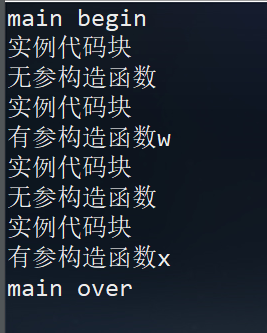Java学习:十一.this和static---实例代码块
本文共 595 字,大约阅读时间需要 1 分钟。
一.语法格式
{ Java代码块1; Java代码块2; … } 二.特点 只要调用构造函数,必然在构造函数调用之前调用实例代码块。public class InstanceTest { public static void main(String[] args) { System.out.println("main begin"); new InstanceTest(); new InstanceTest("w"); new InstanceTest(); new InstanceTest("x"); System.out.println("main over"); } { System.out.println("实例代码块"); } public InstanceTest() { System.out.println("无参构造函数"); } public InstanceTest(String name) { System.out.println("有参构造函数"+name); }} 结果:
 从结果中可以看出,实例代码块在构造函数之前调用,而且调用的次数可以不止一次。 三.作用 为程序员准备的时机,叫做对象构造时机。
从结果中可以看出,实例代码块在构造函数之前调用,而且调用的次数可以不止一次。 三.作用 为程序员准备的时机,叫做对象构造时机。 转载地址:http://uxlk.baihongyu.com/
你可能感兴趣的文章
NetBeans之改变难看的JSP脚本标签的背景色...
查看>>
netbeans生成的maven工程没有web.xml文件 如何新建
查看>>
netcat的端口转发功能的实现
查看>>
netfilter应用场景
查看>>
netlink2.6.32内核实现源码
查看>>
netmiko 自动判断设备类型python_Python netmiko模块的使用
查看>>
NetMizer-日志管理系统 dologin.php SQL注入漏洞复现(XVE-2024-37672)
查看>>
Netpas:不一样的SD-WAN+ 保障网络通讯品质
查看>>
netron工具简单使用
查看>>
NetScaler MPX Gateway Configuration
查看>>
NetScaler的常用配置
查看>>
netsh advfirewall
查看>>
NETSH WINSOCK RESET这条命令的含义和作用?
查看>>
netstat kill
查看>>
netstat命令用法详解
查看>>
Netstat端口占用情况
查看>>
Netty 4的内存管理:sun.misc.Unsafe
查看>>
Netty channelRegistered\ChannelActive---源码分析
查看>>
Netty NIO transport && OIO transport
查看>>
Netty WebSocket客户端
查看>>